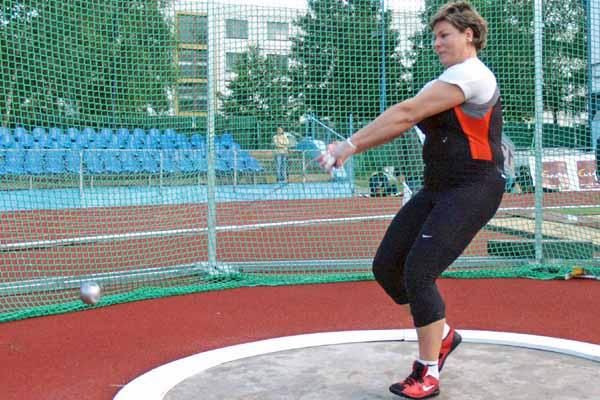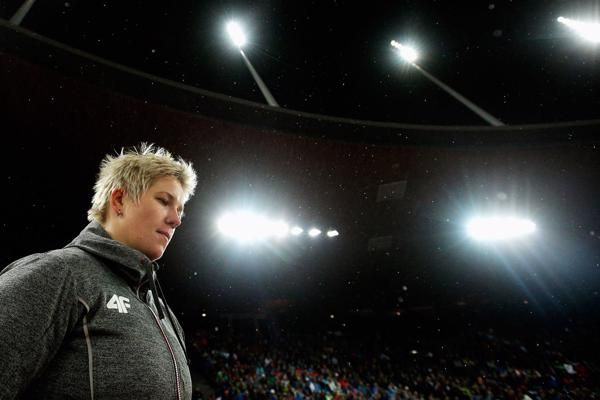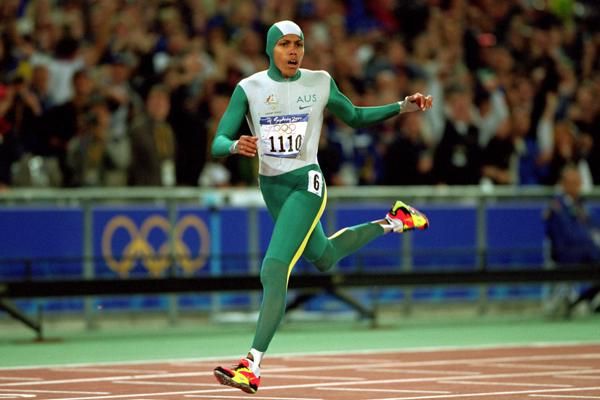Kamila Skolimowska in action in the hammer at the Sydney 2000 Olympic Games (© Getty Images)
In anticipation, few events at the Sydney 2000 Olympic Games seemed as predictable as the women’s hammer.
World record-holder and world champion Mihaela Melinte of Romania and her closest rival, Olga Kuzenkova of Russia, had a lock on the gold and silver medals with only the order to be decided. The rest were battling for the bronze medal.
If that was the pre-ordained order, someone forgot to tell Kamila Skolimowska, who rose to the occasion to take the most unexpected gold medal of the Games. A month short of her 18th birthday and already world U18 champion and world U20 record-holder, the Polish teen may clearly have been one for the future – but few expected the future to arrive on 29 September 2000.
Skolimowska’s victory completed a hammer double for Poland. Szymon Ziolkowski had taken the men’s gold medal a few days earlier. Ziolkowski himself had just turned 24, though that seemed to make him almost a doddering veteran alongside his co-gold medallist.
Sydney was the first Olympics at which the women’s hammer had been contested. The event had made its World Championships debut in Seville the previous year – Melinte and Kuzenokova the gold and silver medallists, respectively – and been introduced at European and Commonwealth level a year before that.
Skolimowska and Ziolkowski both established legacies, especially so in the case of Skolimowska. Before Sydney, Poland had taken just one Olympic and one World Championships bronze medal in men’s hammer. In the most recent decade, Polish throwers Pawel Fajdek and Wojcech Nowicki have been dominant forces.
Skolimowska’s impact was just as pronounced, with a direct link to 2012 and 2016 Olympic champion Anita Wlodarczyk, who has dominated the event throughout the past 10 years, bringing others along in her wake.
Tragically, Skolimowska has not been around to enjoy this success. In February 2009, she died suddenly after suffering a pulmonary embolism while training on Portugal’s Algarve coast. Fittingly, Wlodarczyk won the first of her (so far) four world titles later that year in Berlin.

Sydney 2000: the lead-up
As noted already, Skolimowska was not a gold medal fancy coming into Sydney 2000, but she was clearly an athlete of promise, a young thrower in an even younger event. She became European U20 champion at the age of 14, world U18 champion and a World Championships representative at 16.
Nonetheless, Skolimowska was not ranked in the likely top 10 in Track & Field News’ preview, possibly reflecting her youth and her DNQ in Seville. Some impressive performances may have just missed the publishing deadline, too. Skolimowska threw a world U20 record of 70.66m in late August and defeated one of the medal favourites, Kirsten Munchow, just a week before the Games.
Still, even with Skolimowska coming to Sydney in the best form of her brief career, Melinte and Kuzenkova had more than four metres on her on that year’s world list and boasted the year’s 10 best throws between them. France’s Manuela Montebrun was third on the list at 71.18m with Skolimowska fourth.
Sydney 2000: the competition
Kamila Skolimowska was ready to throw her best when the Olympic competition began. In pulling off an upset, though, it helps if things fall your way. She took care of what she could control, throwing 66.30m in the first qualifying pool behind Kuzenkova’s overall lead of 70.60m.
Then things started to happen. Melinte had warmed up with the others in the second pool but no sooner had the throwers entered the stadium than she was belatedly informed of an earlier doping infraction and escorted back out. The Romanian team had been advised but the information had not been passed on to Melinte.
When throwing did get under way, Montebrun, who had thrown 71.18m in France three weeks earlier, could manage no farther than 57.77m. Suddenly two of the top four throwers for the year were out of contention.
Australia’s Debbie Sosimenko led for two rounds in the final two days later. Despite fervent home crowd support, however, she could not improve on her opening 67.95m and finished fifth.
Skolimowska fouled her first throw, produced a 66.33m effort in the second but then upped the ante in the third round with a world U20 record of 71.16m to take the lead. Still, Kuzenkova threatened: a throw anywhere near her season’s best, much less her outright best, would suffice. She moved to the silver medal position with 69.64m in the third round, then improved to 69.77m with her fourth throw.
But when she most needed to step up, the Russian thrower fouled her final two attempts and the first Olympic gold medal in the women’s hammer belonged to Skolimowska. 35 days before her 18th birthday, she was Olympic champion.
“While you see a chance, take it,” the song goes. Skolimowska soon affirmed the truth of the adage. At the World U20 Championships in Chile, a few weeks later, she failed to qualify for the final. The following year she was fourth at the World Championships in Edmonton, then came back to Australia for two more big wins at the Goodwill Games in Brisbane and the IAAF Grand Prix Final in Melbourne.
The youngest-ever Olympic hammer champion finished fifth in defence of her title in Athens in 2004. Either side of that, she earned European silver in 2002 and European bronze in 2006. She returned to Athens in 2006 for the World Cup, winning with a PB of 75.29m. She extended her lifetime best to 76.83m in Doha in May 2007, moving to fourth on the world all-time list at that time.
At the 2008 Beijing Olympic Games, in what would be her final international championships appearance, she failed to record a valid throw in the final. Her successor, Wlodarczyk, finished fourth.
London 2012: Wlodarczyk picks up the Skolimowska’s gauntlet
With a world title and world record already to her name, Wlodarczyk went on to win the first of two Olympic gold medals in London in 2012.
Wlodarczyk also, quite literally, stepped into Skolimowska’s shoes and put her fate in her late teammate’s hands. As reported by Jon Mulkeen and Marta Mikiel for World Athletics in 2014:
“(In London) Wlodarczyk wore throwing shoes and gloves that used to belong to her old friend, given to her by Skolimowska’s family.
“’When I entered the Olympic stadium in London, I asked Kamila to be with me,’ said Wlodarczyk, whose original silver medal at those Games was upgraded to gold with the eventual disqualification of Tatyana Lysenko.
“I won the medal thanks to her and I dedicated it to her.”
Four years later, Wlodarczyk retained her title at the Rio 2016 Games, spectacularly crowning one of the morning sessions with a world record of 82.29m.
Len Johnson for World Athletics














